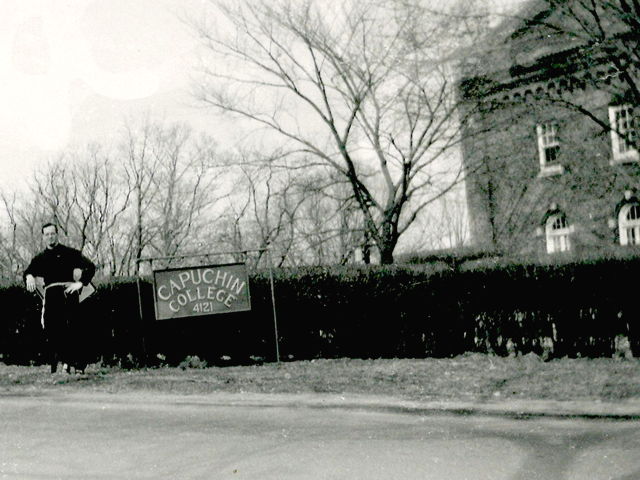 As early as 1908, fathers of our Province have been sent to the Catholic University to qualify themselves for teaching at Saint Fidelis, the clerics Father Benno Haggenmiller, Father Bede Hermann, and Father Felix Kirsch having been the first. They lived with the Franciscan Fathers of the Most Holy Sepulcher, and attended the lectures at the Catholic University from 1908 to 1909, after which they were ordained. At the Provincial Chapter of 1909 the resolution was carried to erect a house of studies somewhere near the Catholic University, and the purchase of suitable ground was approved. Enthusiasm for this project not being very high among some of the older Fathers, who were rather inclined to consider such an undertaking or innovation with distrust, and since an available site for a house of studies near the University was in demand, no definite steps could be taken.
As early as 1908, fathers of our Province have been sent to the Catholic University to qualify themselves for teaching at Saint Fidelis, the clerics Father Benno Haggenmiller, Father Bede Hermann, and Father Felix Kirsch having been the first. They lived with the Franciscan Fathers of the Most Holy Sepulcher, and attended the lectures at the Catholic University from 1908 to 1909, after which they were ordained. At the Provincial Chapter of 1909 the resolution was carried to erect a house of studies somewhere near the Catholic University, and the purchase of suitable ground was approved. Enthusiasm for this project not being very high among some of the older Fathers, who were rather inclined to consider such an undertaking or innovation with distrust, and since an available site for a house of studies near the University was in demand, no definite steps could be taken.
Another petition was sent from Herman to the Provincial chapter of 1915, and interest and enthusiasm for a monastery in Washington was revived on the 16th day of March 1916. The Reverend Definitors decided to buy a certain tract of land on Harewood Road, which was then offered for sale, the question however of erecting a monastery was deferred to some future date . . .
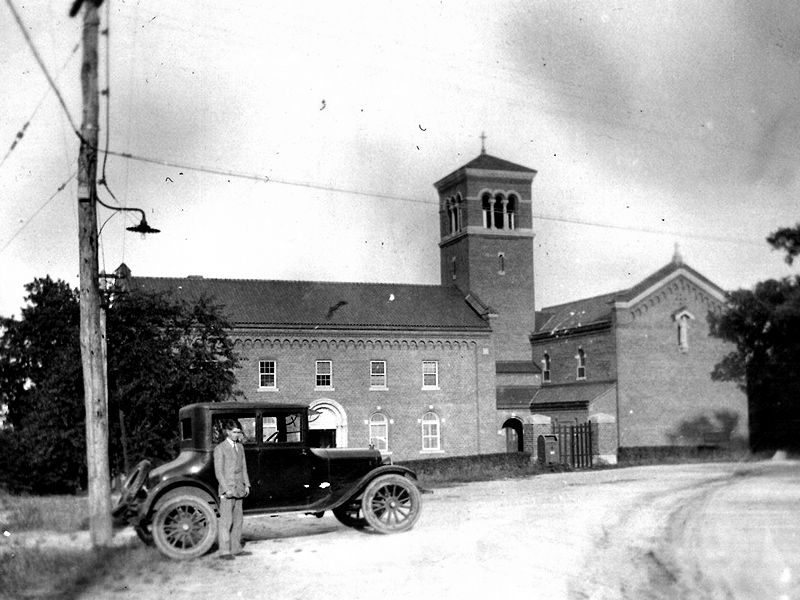 Provincial Ignatius Weisbruck (1915-1918) sought advise from his fellow Provincial Minister, Antonine Wilmer (of Brooklyn NY). Antonine served three consecutive terms as provincial: 1906-1909, 1909-1912, 1915-1918). His response, written from Detroit, MI, is dated October 27, 1915:
Provincial Ignatius Weisbruck (1915-1918) sought advise from his fellow Provincial Minister, Antonine Wilmer (of Brooklyn NY). Antonine served three consecutive terms as provincial: 1906-1909, 1909-1912, 1915-1918). His response, written from Detroit, MI, is dated October 27, 1915:
. . . The problem towards the solution of which you humbly ask my incompetent opinion is indeed a difficult one. Coming in contact with the university professors and alumni more frequently than we, your Province, for that reason alone, maybe called upon to act first or take a definite stand in this matter. For our Province it is all together out of the question to send students to the university now or in the near future. It is true that in our Scholasticate the number of students is increasing, but in the clericate, philosophy and theology combined, we have only 14. Last year we had no ordination, and this year we expect three, but no material for a university.
I believe I am right in saying that all our fathers are averse to sending students to Washington University unless it be one or other of the college professors who would now be especially qualified.
You wanted also my personal opinion. It is this: I do not believe Rome will grant a permission to send students to Washington as long as the Province sends none to Rome. The Irish Provincial told me recently that the invitation to send clerics to the Roman International College became so urgent that he considered them a command and sent a few students who, however, did not remain long. The proviso that our students would take courses at Washington to prepare them for American college work might have some weight in Rome, but I doubt it. If the Capuchins are going to enter the ranks of a teaching Order and if they would stand abreast with the foremost among them, University training would be seen imperative. Force of circumstances compels our Province to stand back for the present, but I do not regret that fact very much
For I have heard [that] Cardinal Farley, Monsignor Lavelle and a goodly number of priests highly praised the work done by our fathers. A few days ago I received from our archbishop, a bishop and several priests unsolicited expressions of appreciation of the work done and results obtained by the professors in our college; no doubt the same can be said of your institution. If our pastors and professors will preserve the same spirit, they will continue to enjoy the esteem of the hierarchy.
But there's the rub. In this argument I stand open to correction, but [what] I am going to say is not from my personal experience, but from hearsay, from much of it. Unfortunately priests, brothers, sisters who go to the university, lose the characteristic traits of their Order. Through frequent intercourse with Religious of other communities, per living for the time being in monastery or convent of a different Rule, a compromise is made at the expense of the community of stricter or more regular observance. It has been said that those returning from the University cannot readily again accustom themselves to the regulations and usages of their home convents....why, some uncultured babblers state that the Doctors and Doctoresses lord it over the rest of the community, who have not been at the university. It ought not be so and need not be so. When the time comes that we must send students to Washington we shall have to send them not withstanding this drawback, but those who must watch over the regularity and seraphic simplicity of our dear Capuchin Order will find their task a burdening one.
If we should have to relinquish our parishes, I, with the majority of the Definitors, would consider it a blessing. Even financially, Detroit (without a parish) stands better than any house of our Province with a parish. In fact, last summer we tried hard to turn over one of our best parishes to Cardinal Farley. We did not succeed. It will be hard to get new parishes except in the wild west or in the backwoods of some Eastern state, but it is a long time yet before we shall have to relinquish the parishes we are serving now.
Trusting these remarks will suffice to make clear our stand in the question on University training for our fathers and begging to correct me if I am too pessimistic in my views, as shown by the experience of your own Province, I am
Fraternally yours S.P.N.J.,
Fr. Antonine OM Cap., Provincial
1918
At the Chapter of 1918, the Very Rev. Fr. Ignatius, ex-provincial, was appointed Superior of the monastery, and the building, though not completed, was first inhabited in August 1918.
The November issue of the Catholic University Bulletin, XXIV, p. 140, published the following description of "The New Capuchin College:”
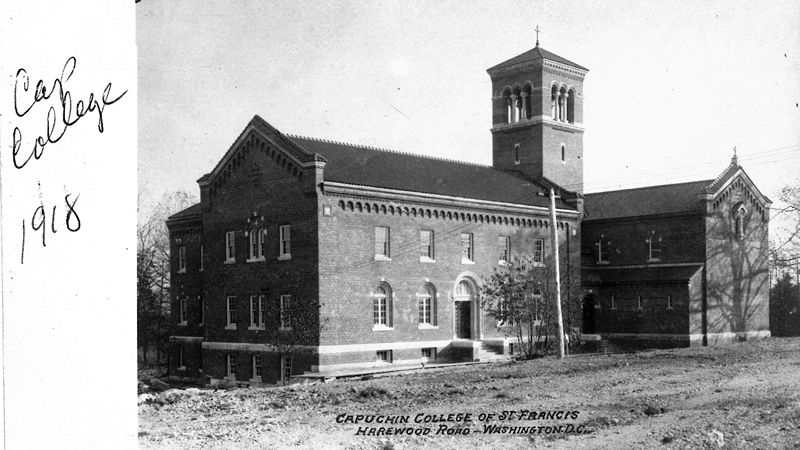 Saint Francis Capuchin Monastery (House of Studies) which the Province of Saint Augustine has erected in the highlands overlooking the University buildings, is situated at the bend of Harwood Road, about [a] 5 minute walk from the University, to which it is affiliated. Built in the style of the old brick architecture of Italy, the home of Saint Francis of Assisi, it may be classed as Italian Romanesque, the style mostly used in the building of the monasteries in Italy. The outstanding features of this unique building, so well expressing the nature of the Capuchin Order, are simple lines and materials, vast spaces of plain wall surfaces, reserve in the use of ornamentation, and unity of design throughout. These give the building a peculiar beauty and stamp it with the character of its purpose, being a true emblem of the Capuchin Order alongside of the other buildings of religious communities affiliated with the university.
Saint Francis Capuchin Monastery (House of Studies) which the Province of Saint Augustine has erected in the highlands overlooking the University buildings, is situated at the bend of Harwood Road, about [a] 5 minute walk from the University, to which it is affiliated. Built in the style of the old brick architecture of Italy, the home of Saint Francis of Assisi, it may be classed as Italian Romanesque, the style mostly used in the building of the monasteries in Italy. The outstanding features of this unique building, so well expressing the nature of the Capuchin Order, are simple lines and materials, vast spaces of plain wall surfaces, reserve in the use of ornamentation, and unity of design throughout. These give the building a peculiar beauty and stamp it with the character of its purpose, being a true emblem of the Capuchin Order alongside of the other buildings of religious communities affiliated with the university.
The monastery, which in this case serves as the house of studies for those of the Order who attend the university, is built of colonial brick, laid in cross bond with heavy mortar joints. The texture is similar to that of Santo Stefano, Bologna, Italy. The roof is of red tile. The building is of fireproof construction, the floors of the corridors and toilets are terrazzo, the floors of the rooms maple, the general wood trim is of oak. Accommodations are provided for 20 rooms, each having his own room, with all the necessary large rooms such as offices, community room, classrooms, refectory etc. A Cloister in the rear with fine Southern exposure makes an ideal private outdoor place for study and prayer.
The chapel serving as choir for the Religious, is also open to the public through a side entrance to a porch adjacent to the monastery. This chapel is outside of the canonical enclosure. Its interior has good proportions and its simplicity is well expressed by the exterior. Only storm glass windows have been placed, leaving the stained glass windows for future possible donations of kindly disposed benefactors of the Order. The high altar, three side altars, sanctuary lamp and Stations have already been donated.
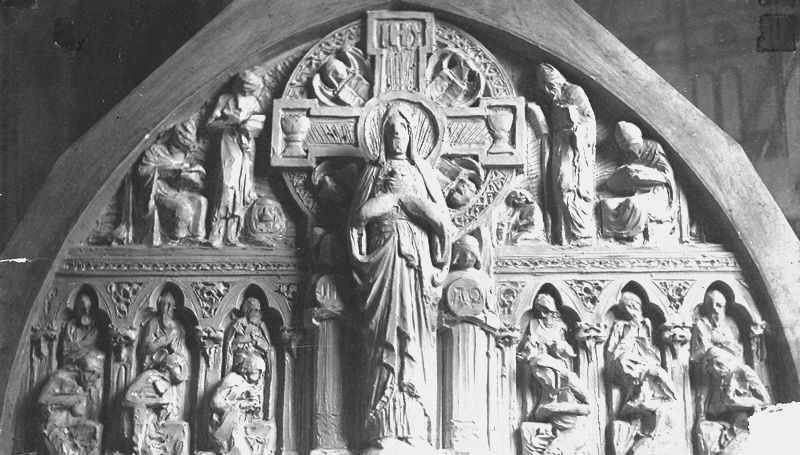 The Capuchins, being followers of St Francis of Assisi, whom they have most fittingly selected as the patron of their new house in the National Capital, were greatly pleased to learn that the builders had begun with the excavation on the Feast of St. Francis, October 4, 1917. The cornerstone was laid on November 30th, 1917, Thanksgiving day, the Feast of All Saints of the Order, by the very Reverend George Doherty, Vice-Rector of the University in the presence of the neighboring Religious, the architect and some Capuchin Fathers. in spite of the great war that brought many difficulties [World War I], the building was practically completed and the Holy Sacrifice of the Mass was offered in the chapel for the first time on St. Francis Day, October 4th, 1918, just one year after ground had been broken.
The Capuchins, being followers of St Francis of Assisi, whom they have most fittingly selected as the patron of their new house in the National Capital, were greatly pleased to learn that the builders had begun with the excavation on the Feast of St. Francis, October 4, 1917. The cornerstone was laid on November 30th, 1917, Thanksgiving day, the Feast of All Saints of the Order, by the very Reverend George Doherty, Vice-Rector of the University in the presence of the neighboring Religious, the architect and some Capuchin Fathers. in spite of the great war that brought many difficulties [World War I], the building was practically completed and the Holy Sacrifice of the Mass was offered in the chapel for the first time on St. Francis Day, October 4th, 1918, just one year after ground had been broken.
The new building was designed and built by the architects, John Kauzor and his brother Anthony Kauzor, the latter now of the Construction Division of the United States Army, and is certainly a credit to their ability. For the time being there are three Fathers occupying the building, with one brother: Fr. Ignatius OM Cap., Fr. Gabriel OM Cap., Fr. Alexius, OM Cap., and Brother Roger. The date of dedication has been postponed to the Spring awaiting more favorable weather.
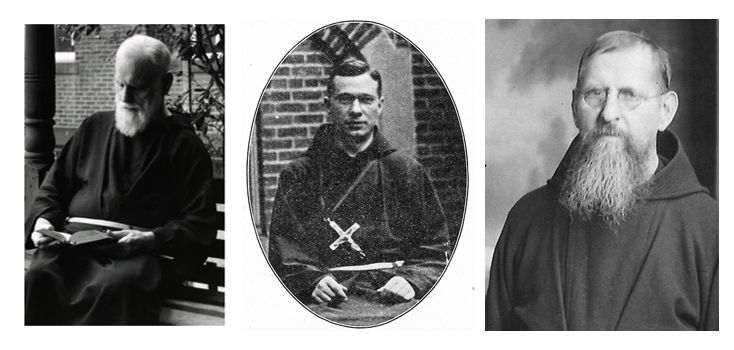
Pictured here are the first residents Ignatius Weisbruck, ex-Provincial Minister who had initiated and oversaw the purchase and building of the DC property, Gabriel McCarthy, a friar ordained in 1916 who would later die as one of the first missionaries in China, and Roger Steffinger who was 54 when he became the "Brother" at Capuchin College. The fourth resident was Alexius Staab. Ordained in September 1918, the month before the building was occupied, Alexius would leave the Order and was secularized in 1925. He died in 1963 in Perry, KS, at the age of 70.
